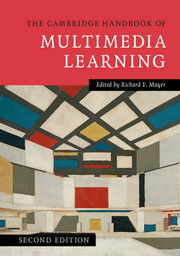Book contents
- The Cambridge Handbook of Multimedia Learning
- The Cambridge Handbook of Multimedia Learning
- Copyright page
- Contents
- Contributors
- Preface
- Acknowledgments
- 1 Introduction to Multimedia Learning
- Part I Theoretical Foundations
- Part II Basic Principles of Multimedia Learning
- Part III Advanced Principles of Multimedia Learning
- Part IV Multimedia Learning of Cognitive Processes
- Part V Multimedia Learning in Advanced Computer-Based Contexts
- Author Index
- Subject Index
Part IV - Multimedia Learning of Cognitive Processes
Published online by Cambridge University Press: 05 August 2014
- The Cambridge Handbook of Multimedia Learning
- The Cambridge Handbook of Multimedia Learning
- Copyright page
- Contents
- Contributors
- Preface
- Acknowledgments
- 1 Introduction to Multimedia Learning
- Part I Theoretical Foundations
- Part II Basic Principles of Multimedia Learning
- Part III Advanced Principles of Multimedia Learning
- Part IV Multimedia Learning of Cognitive Processes
- Part V Multimedia Learning in Advanced Computer-Based Contexts
- Author Index
- Subject Index
Summary
The field of multimedia learning and cognition has expanded in parallel with theories of learning and new affordances of technology. In particular we have seen an explosion in the uses of multimedia to support cognition and learning in a variety of educational platforms that include pedagogical agents that serve as intelligent virtual tutors, simulation-based environments and multimedia game environments that present immersive learning experiences, and communication-based video technologies that present opportunities for communities of inquiry. Examples of these new uses of multimedia tools are presented with a view to the future needs in this field. An important theme of this chapter is that technology must be designed to support, transform, or extend learning for specific situations on the basis of research evidence. Research on the manner in which individuals interact with multimedia and how technology is being designed to support learners using multimedia is presented. Furthermore, methods are described for assessing what learners learn with technology accompanied by appropriate scaffolding. Directions for the next generation of multimedia are discussed in terms of the theoretical and methodological innovations needed to assess cognition and learning with technology.
- Type
- Chapter
- Information
- The Cambridge Handbook of Multimedia Learning , pp. 621 - 702Publisher: Cambridge University PressPrint publication year: 2014

